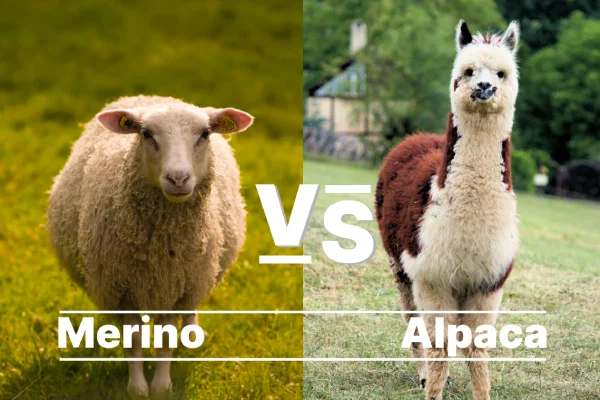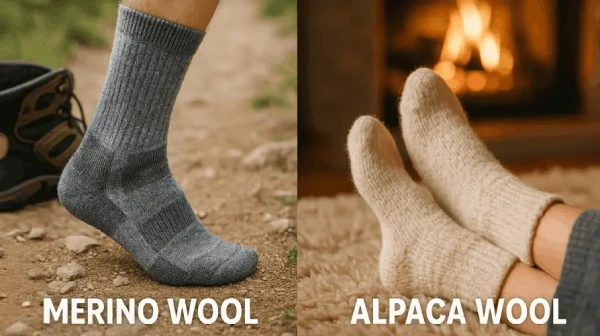
When consumers in Europe and America look for the best wool socks, two materials dominate the conversation: Merino wool socks and alpaca wool socks. Both are premium fibers with strong reputations for warmth, breathability, and natural performance. Yet in recent years, many buyers—especially in the high-end segment—are showing a growing preference for alpaca wool socks.
Why? The answer lies not only in performance, but in comfort, sensitivity, and the overall wearing experience. This article explores the differences between Merino and alpaca, how consumers perceive them, and what the implications are for OEM and ODM sock buyers targeting the European and American markets. For OEM and ODM buyers, understanding these differences is key to designing sock collections that truly meet market needs.
Comfort Matters Most: Fiber Structure and Skin Sensitivity

When evaluating Merino vs alpaca wool socks, the first factor consumers notice is comfort against the skin.
Merino Wool Socks – Soft, Elastic, but Contain Lanolin
Merino wool fibers are extremely fine (often 18–24 microns), which gives them a soft hand feel and makes them far less itchy than traditional wool. Their natural crimp provides elasticity, allowing socks to stretch and return to shape. However, Merino wool contains lanolin, a natural oil that can irritate sensitive skin. For most people, this is not a problem, but individuals with eczema, wool allergies, or very delicate skin may still experience discomfort.
Alpaca Wool Socks – Silky, Itch-Free, Hypoallergenic
Alpaca fibers, by contrast, have a smoother surface scale and contain no lanolin. This makes them naturally hypoallergenic socks, well-suited for people who cannot tolerate sheep’s wool. The sensation is silky rather than springy, often compared to cashmere. For consumers who value itch-free socks or suffer from skin sensitivity, alpaca socks provide a noticeably different comfort experience.
Consumer Preferences in Europe and America

Understanding why consumers make purchasing decisions is crucial for OEM/ODM buyers. Across Europe and America, trends in wool sock materials reflect both practical and emotional factors.
Mainstream Consumers: Trust in Merino Wool Socks
Merino wool has built a strong reputation as the all-purpose performance fiber. Outdoor enthusiasts, athletes, and everyday buyers trust Merino for its ability to wick moisture, regulate temperature, and provide durability. For many consumers, “wool socks” automatically means Merino wool socks. This makes Merino the safe, trusted choice for broad retail distribution.
Premium Buyers: Willingness to Pay for Alpaca Wool Socks
In contrast, premium and luxury buyers are more drawn to alpaca wool socks. The reasons are clear:
- Hypoallergenic benefits for sensitive skin.
- Lightweight warmth due to semi-hollow fibers.
- Exclusivity—alpaca feels rare and boutique compared to widely available Merino.
This group is willing to pay more for luxury wool socks that deliver both comfort and status. Alpaca socks often serve as high-end gifts, wellness products, or indulgent personal purchases.
Merino vs Alpaca Wool Socks in Market Positioning

Market segmentation in Europe and America shows a clear split between performance needs and luxury preferences.
Outdoor and Performance Segment → Merino Wool Socks
For hiking, running, and mountaineering, performance hiking socks made from Merino dominate. Their elasticity, moisture absorption, and proven durability give them an advantage when consumers need gear that adapts to sweat, movement, and changing conditions.
Luxury and Gift Segment → Alpaca Wool Socks
Alpaca excels in categories where comfort and indulgence are more important than technical performance. Examples include:
- Warm socks for winter in urban or indoor environments.
- Hypoallergenic socks for people with allergies.
- Luxury wool socks are positioned as premium fashion or wellness items.
OEM strategy: Merino is ideal for scalable, performance-driven lines, while alpaca is best for premium niche offerings with higher margins.
Yarn Blends and Sock Design Insights for OEM Buyers

The choice between Merino and alpaca is not always binary. In sock production, yarn blending is crucial for balancing performance, durability, and comfort.
- Merino wool socks are often produced with 60–80% Merino, blended with nylon and spandex for reinforcement. The wool provides moisture control and elasticity, while synthetics add abrasion resistance in the heel and toe.
- Alpaca wool socks require more careful engineering. Because alpaca fibers lack elasticity, pure alpaca socks may stretch out. Most manufacturers use 50% alpaca + 30% Merino + 20% nylon/spandex, or similar blends, to ensure durability and fit.
- For luxury lines, 70–80% alpaca with minimal elastic fiber works well, emphasizing comfort and softness.
From an OEM perspective, the blend ratio directly affects both product positioning and price range. A performance-oriented retailer may prefer Merino-heavy blends, while a luxury lifestyle brand may demand alpaca-dominant socks.
Sustainability and Storytelling: A Growing Factor in Consumer Choice

European and American consumers are increasingly concerned with sustainable wool socks and the ethical sourcing of materials.
- Merino wool: Produced at scale, supported by certifications like the Responsible Wool Standard (RWS). Consumers value traceability and assurances that sheep are treated humanely (no mulesing).
- Alpaca wool: Viewed as more eco-friendly due to low methane emissions and gentler grazing habits. The Responsible Alpaca Standard (RAS) now offers traceability for alpaca fibers.
For brands, sustainability is not just compliance—it is a storytelling tool. Marketing alpaca as an eco-friendly, hypoallergenic luxury and Merino as a responsibly sourced performance material helps capture attention in crowded markets.
FAQs
What are the disadvantages of alpaca wool?
Alpaca wool is less elastic than Merino, so socks may stretch out if not blended with nylon or spandex. It is also more expensive and less widely available, making supply chains narrower and prices higher than standard Merino wool socks.
Are alpaca socks worth the hype?
Yes. Alpaca socks are extremely soft, hypoallergenic, and warmer weight-for-weight than Merino. Many buyers value their comfort for sensitive skin, cold-weather use, and luxury appeal. While pricier, they offer durability and a unique wearing experience.
What’s warmer, Merino wool or alpaca?
Alpaca wool tends to be warmer because of its semi-hollow fibers that trap more air for insulation. Merino wool, however, still performs better in high-sweat activities as it absorbs and regulates moisture more effectively, even when damp.
Are Merino wool socks too hot for summer?
No. Lightweight Merino socks are excellent for summer because the fiber naturally regulates temperature, wicks sweat, and prevents overheating. This makes Merino wool versatile for year-round wear, from cold winters to warm summer climates.
How to maintain alpaca wool?
Alpaca wool socks should be washed gently in cool or lukewarm water using mild detergent. Avoid twisting or wringing, and always air-dry flat. With proper care, alpaca socks retain their softness, warmth, and shape for many years.
Conclusion: Merino vs Alpaca Is About Choice, Not Competition

In the debate of Merino vs alpaca wool socks, there is no single winner. Instead, each fiber plays a distinct role:
- Merino wool delivers reliability, elasticity, and broad consumer trust in performance socks.
- Alpaca wool offers unmatched comfort, hypoallergenic properties, and luxury appeal for discerning buyers.
For brands and OEM buyers targeting Europe and America, the smartest strategy is to integrate both into a product line—Merino for the all-season, high-performance market, and alpaca for the comfort-driven, premium segment. Together, they cover the full spectrum of consumer demand, from functional performance hiking socks to luxury wool socks for sensitive skin.
👉 Ready to create your own custom wool sock line? Partner with Max Hosiery for OEM/ODM solutions that turn Merino and Alpaca into market-winning collections.
